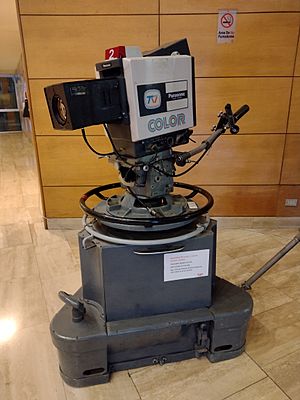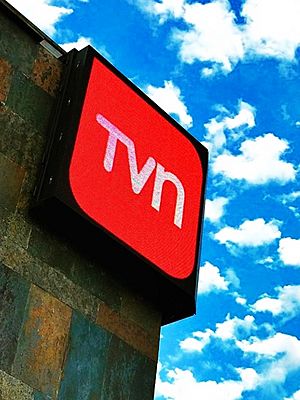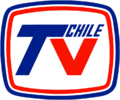Televisión Nacional de Chile facts for kids
Logo used since 2020
|
|

TVN headquarters in Santiago.
|
|
| Type | Free-to-air public service broadcaster |
|---|---|
| Country | Chile |
| Headquarters | Bellavista 0990 Providencia, Santiago Metropolitan Region, Chile |
| Programming | |
| Language(s) | Spanish |
| Picture format | 1080i HDTV (downscaled to 480i for the SDTV feed) |
| Ownership | |
| Sister channels | NTV TVN 3 TV Chile Canal 24 Horas |
| History | |
| Founded | January 31, 1969 |
| Launched | 18 September 1969 |
| Founder | Eduardo Frei Montalva |
| Availability | |
| Terrestrial | |
| Digital VHF | Listings may vary |
Televisión Nacional de Chile, or TVN, is a TV channel in Chile that serves the public. It was started by President Eduardo Frei Montalva and began broadcasting across the country on 18 September 1969. Since then, TVN has grown a lot. It is now one of the most important TV channels in Chile and South America.
A law from 1970 said that TVN must be a public channel. This means it should be fair, open to different ideas, and represent the people. TVN's job is to show Chilean culture, support democracy, human rights, and care for the environment. It also needs to respect everyone's differences. The National Television Council helps guide TVN's programs.
TVN has been a leader in new technology in Chile. It was the first TV network to broadcast across the whole country. It was also first to use satellite broadcasting, color TV, stereo sound, and high-definition TV. Many of its soap operas have been very popular in Chile. They are known for showing real-life stories and social issues. TVN's news programs have also been very important during big events, like the 2010 earthquake. TVN news teams often arrived in affected areas before the army or government. Today, TVN offers many different programs. It is also seen as the second most trusted TV news source in Chile.
TVN's main office is in Providencia, Santiago Metropolitan Region. It has 638 employees. TVN also has nine other TV centers around the country. The President of Chile chooses the chairperson of TVN's board, who serves for four years. Six other board members are chosen by the Senate and the President for eight years. A seventh member is chosen by the TVN staff. As of 2025, Andrea Fresard is the chairperson. Alfredo Ramírez is the executive director.
TVN is the only TV company in Chile owned by the public. It competes with private channels. TVN pays for itself mainly by selling advertising, which it has done since it started. A law from 2013 allows TVN to run TV services and create TV shows. It can also act as a telecommunications provider. TVN is part of the National Association of Television (Anatel) and other groups.
Contents
How TVN Started
The idea of television in Chile began with the Television Law of 1958. This was the first law about TV in the country. It was put in place by President Jorge Alessandri. This law was needed to control the three TV channels that already existed. These channels were owned by universities and were private.
In the 1960s, the Chilean government felt it needed its own TV channel. President Eduardo Frei Montalva wanted a public TV station that could reach the whole country. This was a big challenge because Chile has a very long shape. So, a company was created. Its first partners were government-owned companies like CORFO, Chilefilms, and Entel. Televisión Nacional de Chile officially started on 31 January 1969. It used the country's main telecommunications network.
Early Days of TVN
First Stations
The first TVN station was in Arica. It started broadcasting on 12 December 1968. President Eduardo Frei Montalva officially opened it. This station mostly showed programs from Santiago. Then, on 1 February 1969, channel 6 in Punta Arenas began broadcasting. President Frei Montalva also attended this opening. The day before, 31 January, is considered TVN's official birthday.
Growing Across Chile
On 21 May 1969, Talca started getting TVN broadcasts from Santiago. On 15 July 1969, channel 6 in Antofagasta officially opened. It made some local programs and also showed programs from Santiago a few days later. Finally, on 18 September 1969, which is Chile's Independence Day, TVN in Santiago started broadcasting on channel 7. This channel became the main station. It shows live national events, which other stations sometimes broadcast too. Before its official launch, this channel had shown test broadcasts of sports and news events.
Building the National Network (1969–1973)
First Studios
TVN officially began regular broadcasts in Santiago on 18 September 1969. It reached 6 of the 25 provinces in Chile at that time. It had more than twelve hours of programs every day. At first, TVN's studios were in a house in Santiago. Later, they moved to a new, permanent studio in Providencia, which opened on 20 August 1970.
Expanding Across Chile
TVN continued to expand. It launched in Iquique on 23 May 1970. Then in Calama and Chuquicamata on 2 July. By August of that year, it reached Valdivia, Osorno, Puerto Montt, and Ancud. Later, it expanded to Coyhaique in May 1971, La Serena and Coquimbo in June 1972, and Castro in early 1973. By 1970, TVN was an important source of information. A new law (Law 17,377 of 1970) officially recognized it as a "public" station.
How TVN Was Used
Originally, TVN was meant to be a fair and independent news source. Its goal was to "connect, inform, entertain, and educate the Chilean family." However, in later years, the governments of President Salvador Allende and then Augusto Pinochet used the channel to spread their political ideas.
Military Rule (1973–1990)
Changes After the Coup
On 11 September 1973, after a big change in government, TVN stopped broadcasting for three days. Its offices were attacked, and many old TV recordings were destroyed. During these three days, another channel, Canal 13, was allowed to use TVN's national network. When TVN started broadcasting again, it became the official TV channel for the new military government. The news and programs were strictly controlled. This made Canal 13's news program, Teletrece, more popular because it was seen as more open. In January 1975, TVN opened a station on Easter Island.
Color Television Arrives

The first test of color TV in Chile was by TVN on 6 February 1978. This was during the Viña del Mar International Song Festival. Before this, a rule made it hard to bring color TV sets into Chile. This rule was removed on 10 April 1978. After that, color TV broadcasts officially began. Chile adopted the NTSC system from the United States. Many of TVN's programs were already ready for color. Shows like La cafetera voladora used this new technology. This allowed for many special effects, which amazed children at the time.
Growth and Changes
Throughout the 1980s, TVN grew with new programs and technology. It was the first Chilean TV network to broadcast by satellite. It also launched a second channel in 1986 and an international service in 1989. However, TVN's news program, 60 Minutos, was criticized for changing the news to support the government.
Because of this, TVN lost trust and viewers. This led to a need to rethink TVN's purpose. As Chile moved towards democracy, new government leaders prepared to make big changes to the company.
Return to Democracy (1990–2000)
When democracy returned in the 1990s, President Patricio Aylwin signed a new Television Law in 1992. This law made TVN an independent public company. It said that a board of directors would manage TVN. The President and the Senate would choose the board members, along with a representative from the staff.
This law aimed to make TVN fair, open, and independent from the government. It also meant TVN would pay for itself through advertising, without getting money from the government. TVN's second channel was later bought by a businessman and became Mega.
More Progress
With its new structure, TVN achieved many things. It created new regional TV centers and launched its online service, TVN.cl, in 1998. It also had its first test broadcast in high definition in 1999. The Santiago headquarters were completely renovated between 2002 and 2005.
Reaching More Viewers (2000–2015)
TVN welcomed the new millennium with a special program called 2000 Hoy. This show was broadcast on 31 December 1999. It showed the arrival of the year 2000 from different parts of the world. After a message from President Eduardo Frei Ruiz-Tagle, a music show was broadcast from Santiago. TVN's success continued into the 2000s. Many programs became popular, like the soap opera Romané, which had very high ratings for its final episode. TVN also broadcast the 2000 Sydney Olympics that year.
In December 2000, the executive director, René Cortázar, resigned. This happened after a disagreement about an episode of the Informe Especial program. The episode was about the CIA's actions in Chile during President Salvador Allende's time. Some board members wanted changes to the program, but it was broadcast as planned. Even though TVN was doing very well financially under Cortázar, he left the company.
What's on TVN?

Televisión Nacional de Chile creates many of its own shows. It also works with other production companies. Since it started, TVN has shown news, dramas, foreign shows, and sports events. Every day, the channel starts with the news program 24 AM. This is followed by a long morning show. In the afternoon, there are two main news programs: 24 Tarde at 1:00 pm and 24 horas central at 9:00 pm. The evening news is considered the most important.
Soap operas and TV series, both made by TVN and from other countries, usually fill the afternoon schedule. Since 2004, TVN has also shown soap operas at night. In the afternoon, besides dramas, shows like Rojo are broadcast. In the evening, after 24 horas central, the weather forecast TV Tiempo is shown, followed by other programs or soap operas. Then, the midnight news, Medianoche, is broadcast. On weekends, you can find cultural, children's, or political discussion programs like El informante and Estado nacional.
News from Chile and around the world is presented under the name 24 horas since 1990. There are several news editions each day. All news programs are part of the 24-hour news channel, Canal 24 Horas. This channel can break into the main channel's programs during emergencies, like earthquakes, to give live news updates. Before its current name, the news programs had different names like Telediario and 60 minutos.
Special Programs
TVN broadcasts some special programs every year or from time to time. These include debates between presidential candidates, general elections, and special events. It also shows messages from the President of the Republic. Another important event is the Teletón, a fundraising event. TVN has broadcast this event since 1978, along with other Chilean TV channels. It lasts for 27 hours. TVN also covers the New Year's fireworks and music show in Valparaíso every year.
TVN has been the official channel for the Viña del Mar International Song Festival for many years. It also broadcasts the Festival del Huaso de Olmué and the Fiesta de la Independencia de Talca. Some sports events shown on TVN include the Summer Olympic Games (and Paralympic Games), the FIFA World Cup, the Copa América, and the Santiago Marathon.
The network also broadcasts the Great Military Parade of Chile. This parade happens every year in Chile on 19 September in O'Higgins Park in Santiago. TVN produces the TV coverage of this event, and it gets very high ratings.
TVN's Services
TVN has a main channel that broadcasts across Chile by satellite. It reaches 98% of the population. It also has nine regional channels with their own production centers. TVN has an international service called TV Chile. There's also a news channel called Canal 24 Horas and its online version, 24Play. TVN has several websites, a music label called TVN Records, and a free streaming service called TVN Play.
| Name | Type | Area | Creation date | Description | |
|---|---|---|---|---|---|
| TVN | Free to air TV channel | 18 September 1969 | General programs. Main channel. | ||
| NTV | Free to air TV channel | 8 August 2021 | Educational and cultural programs. | ||
| TVN 3 | Cable TV channel | 26 July 2023 | Old programs from the archives. | ||
| TV Chile | Cable TV channel | Worldwide | 10 March 1989 | International TV channel. | |
| Canal 24 Horas | Cable TV channel | Worldwide | 4 March 2009 | News TV channel. | |
| 24 Play | Internet TV channel | Worldwide | 1 July 2017 | News TV channel. Shows the same programs as Canal 24 Horas online. | |
| TVN Play | Streaming | Worldwide | 1 September 2016 | Streaming service for people outside Chile. | |
| 5 July 2021 | Free streaming service for people in Chile. | ||||
| Regional Network | |||||
| TVN Regiones | Red Antofagasta | Free to air TV channel | 11 April 1996 | General programs. | |
| Red Atacama | Free to air TV channel | 1992 | General programs. | ||
| Red Coquimbo | Free to air TV channel | 28 June 1993 | General programs. | ||
| Red Valparaíso | Free to air TV channel | 15 August 1991 | General programs. | ||
| Red O'Higgins | Free to air TV channel | June 1993 | General programs. | ||
| Red Maule | Free to air TV channel | Maule | 5 February 1991 | General programs. | |
| Red Biobío | Free to air TV channel | Ñuble and Biobío | 3 July 1990 | General programs. | |
| Red Araucanía | Free to air TV channel | 1991 | General programs. | ||
| Red Austral | Free to air TV channel | 1 February 1969 | General programs. | ||
Regional Channels
- TVN Red Antofagasta (in Antofagasta Region).
- TVN Red Atacama (in Atacama Region).
- TVN Red Coquimbo (in Coquimbo Region).
- TVN Red Valparaíso (in Valparaíso Region).
- TVN Red O'Higgins (in O'Higgins Region).
- TVN Red Maule (in Maule Region).
- TVN Red Biobío (in Bío Bío Region and Ñuble Region).
- TVN Red Araucanía (in Araucanía Region).
- TVN Red Austral (in Magallanes and Chilean Antarctica Region).
TVN Buildings
The main office of Televisión Nacional de Chile is in Providencia, Santiago Metropolitan Region. This building is home to the national channel, internet services, and the music label. It opened in 1970 and was renovated between 1999 and 2005. On 1 December 2004, a fire broke out due to an electrical problem. The main channel stopped broadcasting for an hour, but no one was hurt.
Many Chileans know this building, and it's a place where tour guides sometimes visit. Inside, there's a large open area called "Patio de las Comunicaciones." This area is sometimes used for company events and TV shows. The building also has three studios for drama productions. There's a center for news, a video editing room, and an auditorium. It also has storage for props, document archives, a cafeteria, and dressing rooms. There are also offices for the board of directors and other staff.
Televisión Nacional de Chile has other production centers with newsrooms and studios. These are in Antofagasta, Copiapó, La Serena, Valparaíso, Rancagua, Talca, Concepción, Temuco, and Punta Arenas. There is also a business office in Arica y Parinacota Region.
TVN's Leaders
Chairpersons of the Board
- 1969–1970: Mario Mosquera
- 1970–1973: Eugenio González Rojas
- 1992–1994: Jorge Donoso
- 1994–2000: Luis Ortiz Quiroga
- 2000–2001: Jorge Navarrete Martínez
- 2001–2004: Marco Colodro Hadjes
- 2004–2006: Carlos Mladinic
- 2006–2007: Francisco Vidal Salinas
- 2008: Pablo Keller Huberman
- 2008–2010: Mario Papi
- 2010–2012: Leonidas Montes Lira
- 2012–2013: Carlos Zepeda Hernández
- 2013–2014: Mikel Uriarte Plazaola
- 2014–2018: Ricardo Solari
- 2018: Francisco Orrego
- 2018–2019: Bruno Baranda
- 2019–present: Ana Holuigue
TVN's Look and Feel
Mascots
From 1970 to 1973, TVN had a mascot named Tevito. Its theme music was "Charagua," composed by Víctor Jara. After the big government change on 11 September 1973, Tevito was removed from TV. Many videos of it were destroyed. It was replaced by other characters. However, Tevito was used again on 11 March 1990, when President Patricio Aylwin took office. Today, "Charagua" is still linked to TVN in Chile.
Tevito
Tevito was a happy cartoon dog. He was shown in many ways, sometimes as a boxer or wearing glasses. He even dressed as a vampire. He played the trutruca, a traditional instrument of the Mapuche people. Often, Tevito carried a bass drum on his back, like a street musician. He would hit the drum with long mallets. The character was created by Carlos González, an art student. Tevito became a popular part of Chilean culture.
Ito e Ita
Ito e Ita were TVN's second mascots. They appeared in 1974 and stayed on screen until 1978, when color TV arrived. They often had music from the band Los Huasos Quincheros.
Conejito TV
In 1979, a third mascot for color TV was introduced. It was a rabbit named Conejito TV. This mascot was used until 1984 and often appeared with Gabriela Velasco.
Clorofilo
In 1987, a green alien mascot was introduced. After a contest, it was named Clorofilo, which means chlorophyll. Clorofilo was removed from TV in mid-1988. Since then, TVN has not used cartoon characters as mascots.
Logos
Televisión Nacional de Chile's look is based on promoting Chilean culture. Since it started, the colors of the Chilean flag have often been used in its logos. For example, the current logo mainly uses red.
Logo History
The first logo, from 18 September 1969, looked like a TV screen. Its edges had the colors of the Chilean flag. Inside, it said "TV Chile." The text was first black, then changed to blue in 1978 when color TV came. The colors on the screen's border were changed, and the letters "T" and "V" became separate.
On 1 April 1984, the logo changed to an "N" with ribbons in Chilean flag colors. Three years later, a changed version of the 1978 logo returned. It first appeared on TVN's news in 1987. This updated logo had a different shade of blue on the border. The 1984 design was still used as a secondary logo until January 1988. When TV Chile launched in 1989, it used the same logo as TVN. This design was used until 1990. Between March and November 1990, the screen borders changed to rainbow colors, and the text "Chile" was light blue.
The 1990 design, launched on 23 November 1990, removed the "screen" shape. It had "TV" in black text, and "Chile" was replaced with a stripe of Chilean colors. A changed version in 1993 made the text grey and more slanted. The blue stripe became lighter. On 1 September 1996, the letter "N" was added, and the white stripe was removed. The blue and red stripes also became lighter.
A temporary logo, still using the 1996 design, appeared in late 2003. This led to the 2004 logo, which featured the white TVN logo inside a red square.
On 4 January 2004, the 1996 design was replaced by the "red square" logo. This logo had the TVN text inside a red square. A modified version with rounded edges was introduced on 9 August 2016. The "red square" symbol first appeared in September 1994. It was used more and more in advertising. In 2001, it was first used on screen to show the content rating system. It became very noticeable, and in January 2004, it became the main company logo.
Since its release, the "red square" has influenced the logos and designs of all TVN brands. In October 2020, the red square was removed. Now, it's just the TVN text in red. However, there is also a separate blue logo.
See also
 In Spanish: Televisión Nacional de Chile para niños
In Spanish: Televisión Nacional de Chile para niños
- List of television stations in Chile
- Television in Chile
- Public broadcasting
















